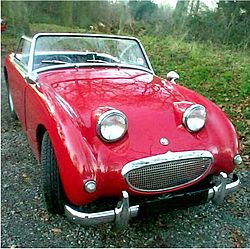Austin-Healey Sprite
| Austin-Healey Sprite | |
|---|---|
| Manufacturer: | BMC |
| Production: | 1958-1971 130,000 |
| Class: | sports car |
| Body Styles: | FR 2-door roadster |
| Predecessor: | Austin-Healey 100 |
| Similar: | MG Midget |
| Related: | Austin A35 Morris Minor |
| Mark I Frogeye/Bugeye | |
| Austin Healey Sprite '61Template:Unverifiedimage | |
| Production: | 1958-1961 38,999 |
| Engines: | 948 cc A-Series I4 |
| Mark II | |
| Production: | 1961-1965 |
| Engines: | 948 cc A-Series I4 1098 cc A-Series I4 |
| Mark III | |
| Production: | 1965-1971 |
| Engines: | 1275 cc A-Series I4 |
The Austin-Healey Sprite was a small open sports car designed by Donald Healey.
It release was announced by British Motor Corporation in 1958. It was a small, low cost sports car designed to fill the hole in the market left by the small pre-war Austin seven sports cars. The car was designed by the Healey Motor Company within the bounds of their partnership with British Motor Corporation.
It first went on sale at a price of £669.
It was based on the Morris Motor Company A-series engine and used as many components from existing cars as possible to keep the cost to a minimum.
Mark I

The British Mark I sprite was known as the Frogeye in the UK and the Bugeye in America because of its distinctive headlights mounted on top of the centre bonnet (hood). The front sheet-metal assembly - bonnet and wings (fenders) - was a one piece unit, hinged from the back, that swung up to allow access to the engine compartment. Both the engine and suspension were derived from the A35 & Morris Minor models produced by Austin Morris. It used the 948cc engine fitted to these models upgraded with twin 1 1/8" inch SU carburetters. The front suspension was a coil spring and wishbone arrangement, with the arm of the Armstrong lever shock absorber serving as the top suspension link. The rear axle was both located and sprung by quarter-elliptical leaf springs, again with lever arm shock absorbers. There were no exterior door handles; one reached inside to open the door. There was also no boot (trunk) lid, and access to the spare wheel and rear storage was gained by tilting the seat backs forward and reaching under the rear deck.
Engine:
Mark II
The Mark II initially used the same 948cc engine but later introduced a 1098cc engine. This engine actually has the same stroke and bore, and therefore capacity, as the Morris Minor 1000 and the Morris 1100, so the different nominal capacities of these three cars seem to be the idea of the marketing department. It also moved the headlights to a more conventional position in the wings, adopted the tail lights from the soon to be announced MGB, and introduced a boot lid and conventional rear bumper bar. The result was a far more conventional looking car but carrying little extra weight. These are sometimes referred to as square bodied Sprites. Front disc brakes were also introduced along with the 1098cc, and wire wheels became an option.
There was a IIA with some engine improvements, notably larger camshaft bearings. This model was also rebadged as the Mark I MG Midget, without Donald Healey's consent or approval.
Innocenti also produced a version of this vehicle. Featuring styling by Ghia, the Innocenti 950 Spider and later 1100 Spider was produced from 1961 through 1968.
Engines:
- 1961–1964 - 948 cc A-Series I4, 46 hp (34 kW) at 5500 rpm and 53 ft·lbf (72 Nm) at 3000 rpm
- 1962–1964 - 1098 cc A-Series I4, 56 hp (42 kW) at 5500 rpm and 62 ft·lbf (84 Nm) at 3250 rpm
Mark III
The Mark III was also badged as the Mark II MG Midget. Differences between the two were in the grille and some body detailing only. It introduced wind-up windows with hinged quarterlights and exterior door handles, and for the first time the car could be locked, although with a soft top roof this gave minimal protection. The rear suspension went to semi elliptical leaf springs. The car had gained an appreciable amount of weight and was far more comfortable but not nearly so lively.
Engine:
Mark IV
Besides receiving a larger 1275cc engine, the MK-IV (and its cousin the MK-III MG Midget)had several cosmetic changes. Most notable is the change from a removable, trunk-stowable convertible top (hood) to a permanently affixed, manually foldable top (hood). The larger engine lost some of its advantage through the use of smog pumps and other emissions requirements in the U.S.
Engine:
The Sprite was cancelled in 1971, being sold as simply the Austin Sprite that final year.
The later MG Midgets, 1974-79 used a 1500 cc Triumph engine in its place. The Triumph engine having four exhaust ports as opposed to the three for the Morris A-series, allowed more performance development, but is known for mechanical problems as well as rubber bumpers.
The Sprites and Midgets sharing the same body are generally called Spridgets by classic car buffs.
References
- John Heilig (1996). MG Sports Cars. Motorbooks. ISBN 0-7603-0112-3.
- Ray Bonds (2003). The Illustrated Directory of Sports Cars. Motorbooks. ISBN 0-7603-1420-9.
- "MG Midget Home Page". MG Enthusiasts. Retrieved March 22.
{{cite web}}: Check date values in:|accessdate=(help); Unknown parameter|accessyear=ignored (|access-date=suggested) (help)
